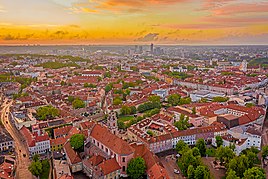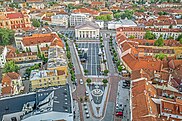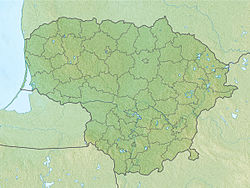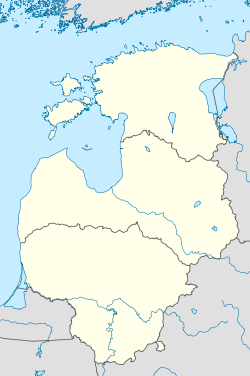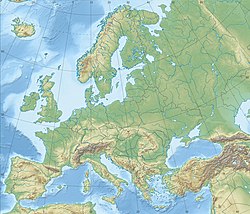ভিলনিয়াস
ভিলনিয়াস (- [ˈvʲɪlʲnʲʊs] () লিথুয়ানিয়ার রাজধানী ও সর্ববৃহৎ শহর। ২০১৮ সালের পরিসংখ্যান অনুযায়ী এ শহরের মোট জনসংখ্যা ৫৭৪,১৪৭ জন। ভিলনিয়াস লিথুয়ানিয়ার দক্ষিণ-পূর্ব অংশে অবস্থিত এবং এটি বাল্টিক রাষ্ট্রসমূহের মধ্যে দ্বিতীয় বৃহত্তম শহর। ভিলনিয়াস লিথুয়ানিয়া প্রধান সরকারী প্রতিষ্ঠানের এবং ভিলনিয়াস জেলা পৌরসভার আসন। জিএডব্লিউসি গবেষণার মতে, ভিলনিয়াসকে গামা গ্লোবাল শহর হিসাবে শ্রেণীবদ্ধ করা হয়েছে এবং এটি তার পুরাতন শহরের স্থাপত্যের জন্য পরিচিত, যা ১৯৯৪ সালে ইউনেস্কো কর্তৃক বিশ্ব ঐতিহ্যবাহী স্থান হিসেবে স্বীকৃত হয়। দ্বিতীয় বিশ্বযুদ্ধের পূর্বে ভিলনিয়াস ইউরোপের বৃহত্তম ইহুদি কেন্দ্রগুলোর অন্যতম ছিল। ইহুদিদের প্রভাবে কারণে একে “লিথুয়ানিয়ার জেরুসালেম” হিসাবে বর্ণনা করা হয়েছে এবং ১৮১২ সালের দিকে নেপোলিয়ন একে “উত্তরের জেরুসালেম” নাম দিয়েছিলেন। ২০০৯ সালে ভিলনিয়াস অস্ট্রিয়ার শহর লিনজের সাথে একত্রে ইউরোপের সাংস্কৃতিক রাজধানী ছিল।
| ভিলনিয়াস | |
|---|---|
| শহর | |
| ডাকনাম: লিথুয়ানিয়ার জেরুসালেম,[১] উত্তরের রোম,[২] উত্তরের অ্যাথেন্স,[৩] নতুন বেবিলন,[৪] পালেমুনের শহর/রাজধানী[৫] | |
| নীতিবাক্য: Unitas, Justitia, Spes (Latin: Unity, Justice, Hope) | |
 Interactive map of Vilnius | |
| Location within Lithuania##Location within the Baltics##Location within Europe | |
| স্থানাঙ্ক: ৫৪°৪১′ উত্তর ২৫°১৭′ পূর্ব / ৫৪.৬৮৩° উত্তর ২৫.২৮৩° পূর্ব | |
| দেশ | |
| কাউন্টি | |
| Municipality | Vilnius City Municipality |
| রাজধানী | লিথুয়ানিয়া |
| প্রথম উল্লেখিত | ১৩২৩ |
| Granted city rights | 1387 |
| Elderships | |
| সরকার | |
| • ধরন | নগর পরিষদ |
| • মেয়র | Remigijus Šimašius (লিবারেল) |
| আয়তন | |
| • শহর | ৪০১ বর্গকিমি (১৫৫ বর্গমাইল) |
| • মহানগর | ৯,৭৩১ বর্গকিমি (৩,৭৫৭ বর্গমাইল) |
| উচ্চতা | ১১২ মিটার (৩৬৭ ফুট) |
| জনসংখ্যা (2018)[৬] | |
| • শহর | ৫,৩৬,৬৩১ |
| • ক্রম | (53rd in EU) |
| • জনঘনত্ব | ১,৩৯২/বর্গকিমি (৩,৬১০/বর্গমাইল) |
| • পৌর এলাকা | ৬,৪১,২২০ |
| • মহানগর | ৮,০৫,৩৬৭including Vilnius County |
| • মহানগর জনঘনত্ব | ৮৩/বর্গকিমি (২১০/বর্গমাইল) |
| বিশেষণ | Vilnian |
| সময় অঞ্চল | EET (ইউটিসি+2) |
| • গ্রীষ্মকালীন (দিসস) | EEST (ইউটিসি+3) |
| পোস্ট কোড | 01001-14191 |
| এলাকা কোড | (+370) 5 |
| GDP (nominal) Vilnius county[৭] | 2017 |
| - Total | €17.2 billion($38 billion, PPP) |
| - Per capita | €21,300($47,000, PPP) |
| HDI (2017) | 0.896[৮] – very high |
| ওয়েবসাইট | www |
| প্রাতিষ্ঠানিক নাম | Historic Centre of Vilnius |
| ধরন | Cultural |
| মানদণ্ড | ii, iv |
| মনোনীত | 1994 (18th session) |
| সূত্র নং | [১] |
| UNESCO region | Europe |
নামকরণ ও উৎপত্তি
সম্পাদনাশহরের নাম ভিলনিয়াস ভিলনিয়া নদী থেকে এসেছে।
শিক্ষা
সম্পাদনাভিলনিয়াস শহরটিতে ১২ টি প্রাথমিক বিদ্যালয়, ১৯টি প্রো জিমন্যাসিয়াম এবং ৪২ টি জিমন্যাসিয়াম রয়েছে। শহরে অনেক বিশ্ববিদ্যালয় আছে। সবচেয়ে বড় ও পুরাতন বিশ্ববিদ্যালয় হল ভিলনিয়াস বিশ্ববিদ্যালয়, যার ছাত্র-ছাত্রী সংখ্যা হল ২০,৮৬৪ জন। এ বিশ্ববিদ্যালয় কিউএস ওয়ার্ল্ড ইউনিভার্সিটি র্যাংকিং অনুযায়ী বিশ্বের শীর্ষ ৫০০ বিশ্ববিদ্যালয়ের মধ্যে স্থান পেয়েছে। ইউনেস্কো, ন্যাটো ও অন্যান্য প্রকল্পে এই বিশ্ববিদ্যালয় অংশগ্রহণ করেছে। এটি স্নাতকোত্তর পর্যায়ে ইংরেজি ও রুশ ভাষায় শিক্ষা কার্যক্রম পরিচালনা করে, সেইসাথে ইউরোপ জুরে বিভিন্ন বিশ্ববিদ্যালয়ের সাথে সহযোগিতামুলক কার্যক্রম পরিচালনা করে। বিশ্ববিদ্যালয়টি ১২টি অনুষদ, ৭টি ইন্সটিটিউটি ও ৪টি শিক্ষা ও গবেষণা কেন্দ্র নিয়ে গঠিত।
তথ্যসূত্র
সম্পাদনা- ↑ Widespread nickname of Vilnius, that appeared because of a strong Litvak community. Today it is used primarily speaking about the past of the Jewish community of Vilnius, e.g. A book "Vilnius, in search of Jerusalem of Lithuania".
- ↑ Widespread use of the nickname from the XVI c. to this day as a reference to the many Catholic churches and monasteries in Vilnius and overall religious atmosphere in the centre. This nickname was/is used not only by the foreigners, but also by the local population, e.g. Lithuanian cultural figure of the XIX c. Dionizas Poška nicknamed Vilnius "Rome of the North", as, according to him, Vilnius is "the old religious centre, that transformed from a pagan city into the bastion of Christianity". D. Poška, ‘Raštai’, Vilnius, 1959, p. 67
- ↑ Cultural newspaper, that is published in Vilnius from 1990, is named „Šiaurės Atėnai“ (The Athens of the North) as a reference to one of the nicknames of Vilnius, that was widespread nickname of the city, esp. in the first half of the XIX c. and the first half of the XX c. mostly because of Vilnius University. During the interwar period, Polish scientific newspaper, published in Vilnius, was also named "Atheneum Wileńskie".
- ↑ Esp. in the 16th–17th centuries, Vilnius was referred to as the ‘New Babylon’ because of many languages, spoken in the city as well as many religions presented (there were various Christian communities as well as Jews and even Muslim Tatar community). E.g.: S. Bodniak, ‘Polska w relacji włoskiej z roku 1604’, Pamiętnik biblioteki kórnickiej, 2, (Kórnik, 1930), p. 37.
- ↑ This nickname was very popular among the Lithuanian nobility, citizens of Vilnius and used among the poets, esp. during the Baroque period. Many poets of the period, including Maciej Kazimierz Sarbiewski, nicknamed Vilnius "the capital of Palemon" or "the city of Palemon". Živilė Nedzinskaitė, Vilnius XVII-XVIII a. LDK lotyniškojoje poezijoje, Acta Academiae Artium Vilnensis, Vilnius, 2010, p. 16; Eugenija Ulčinaitė, Motiejus Kazimieras Sarbievijus: Antikos ir krikščionybės sintezė; Vilniaus pasveikinimas, Lietuvių literatūros ir tautosakos institutas, Vilnius, 2001, p. 47, 59, 61, 63; etc.
- ↑ Lietuvos statistikos departamentas। "Lietuvos statistikos departamentas"। osp.stat.gov.lt।
- ↑ "Statistinių rodiklių analizė"। Statistics Lithuania।
- ↑ Sub-national HDI। "Area Database - Global Data Lab"। hdi.globaldatalab.org (ইংরেজি ভাষায়)।
